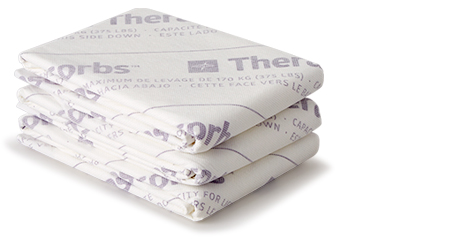Therasorbs is designed to reduce MASD risk factors and promote skin health.
From the makers of Ultrasorbs comes the newest breakthrough innovation in skin and incontinence care. Therasorbs Moisture Management is a system designed to reduce the risk factors of moisture associated skin damage (MASD) for most at risk patients.
An innovative polymer made from droplet polymerization technology allows for this system to be able to wick and absorb fluid better than conventional underpads and existing drypads.
- High performance for fragile skin
- Wicks away fluid and locks in wetness better than standard
dry pads or underpads - Extra strength for easy repositioning; supports up to 375 lbs.

Fight MASD with the skin-centered technology of new Therasorbs.

Therasorbs make a difference. The proof is in the numbers.


Dry Time
Therasorbs dry time was measured with pH indicator paper.
In just 10 minutes the surface of Therasorbs was dry, resulting
in less moisture exposure for patients.
Drying Performance
Within just ten minutes of applying 500mL of liquid,
Therasorbs had an 83–93% better absorption rate
than the competition.
Therasorbs also helps fight incontinence-associated dermatitis (IAD), which is prevalent in up to:



1. MASD vs Pressure Ulcer: What Is That Yellow Stuff? Presented at WOCN 46th Annual Conference. June 24, 2014. Available at http://wocnconference.com/wocn2014/CUSTOM/Handouts/GS5%20-%20Yellow%20Stuff.pdf Accessed August 16, 2017. 2. Care of the Older Person’s Skin: Best Practice Statement. Wounds UK. 2012 (Second edition). Available at http://www.wounds-uk.com/best-practice-statements/care-of-the-older-persons-skin-best-practice-statement-second-edition Accessed August 17, 2017. 3. Lyder CH, Ayello EA. Pressure Ulcers: A Patient Safety Issue. In: Hughes RG, editor. Patient Safety and Quality: An Evidence-Based Handbook for Nurses. Rockville (MD): Agency for Healthcare Research and Quality (US); 2008 Apr. Table 2, [National Pressure Ulcer Staging System]. Available at: https://www.ncbi.nlm.nih.gov/books/NBK2650/table/ch12.t2/ Accessed August 17, 1017. 4-6 Data on file. Available upon request.7. Ermer-Seltun, J. Practical Prevention and Treatment of Incontinence-Associated Dermatitis – a Risk Factor for Pressure Ulcers. Ostomy Wound Management. February 18, 2011. Available at http://www.o-wm.com/content/practical-prevention-and-treatment-incontinence-associated-dermatitis-—-risk-factor-pressure. Accessed June 6, 2017.
